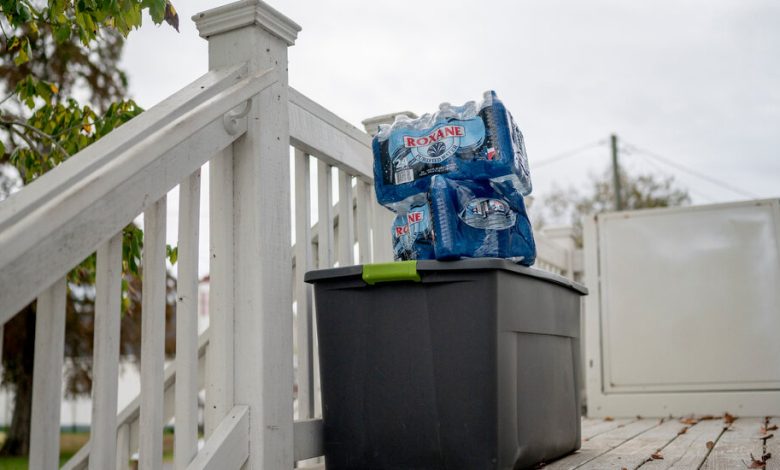Storms, Rising Seas and Salty Drinking Water Threaten Lower Louisiana

First, the flowers and vegetables in Cherie Pete’s backyard in Venice, La., began to die. Then she had to take sweet tea off the menu at her roadside snack shop as saltwater coursed out of her faucets.
“There’s no way I’m serving that to my customers,” said Ms. Pete, 59. “I’m not making people sick.”
All through a sweltering Louisiana summer and into the fall, people in Ms. Pete’s corner of Plaquemines Parish, a marshy strip of land southeast of New Orleans dominated by fishing and the oil industry, endured salty showers and avoided drinking from the tap. Their water comes from the Mississippi River, which runs through the parish like a central nerve.
But this year, droughts in the Midwest sapped the thousands of tributaries that supply the Mississippi, weakening the river and allowing a wedge of saltwater from the Gulf of Mexico to creep dozens of miles upstream.
“You could taste the salt,” said Mary LeFort, 62, of Boothville, which neighbors Venice. “And then they put so much bleach or chlorine in it — you could smell that so strong. Sometimes it’s so strong it wants to burn your eyes.”
People in Plaquemines had been suffering for months when the situation became even more urgent: Forecasts showed that the salt could reach treatment plants in New Orleans by late fall, contaminating the drinking water for hundreds of thousands of people and possibly leaching dangerous materials, including lead, from the city’s aging pipes.
The state requested federal assistance in September, and President Biden approved an emergency declaration as city officials floated an ambitious plan to pipe water from upstream — a project with a potential quarter-billion dollar price tag.
The crisis highlighted a growing concern to communities across America, particularly in the South, where extreme weather exacerbated by climate change has emerged as a threat to safe drinking water.
Last year, a flash flood knocked out a water plant in Jackson, Miss., that serves 150,000 people. That came just weeks after deadly floods ripped through eastern Kentucky, breaking water lines as rampaging rivers and streams obliterated entire neighborhoods. Wildfires in New Mexico, summer heat in Texas and a Western megadrought have all threatened people’s drinking water in recent years.
Saltwater from rising seas, a growing threat to freshwater worldwide, has plagued southeastern Louisiana before. But this was the second year in a row that the region suffered a drinking water crisis, and experts predict more frequent intrusions as climate change continues to cause shifts in Midwestern rainfall.
Commerce adds another complication. For decades, the U.S. Army Corps of Engineers has been dredging parts of the Mississippi to accommodate ever-growing cargo ships, and the agency has long known that its efforts could make saltwater intrusions more likely.
Since 1988, the Army Corps has used sills, or underwater levees, to block the salt, drawing from the same pool of funds as the dredging project. And as the wedge approached New Orleans this year, the Army Corps reinforced a sill about 20 miles southeast of the city.
It helped, as did some rainfall over the river’s tributaries. By November, the threat to the city had mostly receded, though it served as a stark reminder of climate vulnerabilities.
But the reprieve to New Orleans meant little to those who live south of the sill.
The region experienced an epidemic of busted water heaters and rusted dishwashers. Residents worried over smelly faucets and odd rashes, and they rushed to the fire station every time local officials dropped off cases of bottled water — which they used to rinse their hair, feed their pets and make their coffee and sweet tea.
The corps shipped fresh water to treatment plants in lower Plaquemines, and parish officials used booster pumps to pull water from upstream. In mid-October, they told residents that the water was finally safe. But that did little to relieve concerns.
“I still don’t trust it,” Ms. LeFort said. “I’m not going to drink it.”
In a parish that has been buffeted by calamity — Hurricanes Katrina, Ike, Isaac and Ida over the last two decades, and the Deepwater Horizon oil spill in 2010 — clean water is particularly dear. Residents in Ironton can recall fighting for access to it. The majority-Black community was not connected to running water until 1980.
Wilkie Declouet, 59, remembers when he and his neighbors used rainwater and cisterns to survive. This year, he worried as the saltwater crept upriver beneath the passing barges he could see from his porch.
Ironton’s water is piped from upstream, and like New Orleans, the salt did not reach it this fall. But residents say that after decades of neglect, they avoid drinking the water anyway. Mr. Declouet buys dozens of bottles of water each week.
“With the environmental stuff that’s changing around us,” he said, “we don’t know how long we’re going to be here.”
New Orleans could also be vulnerable again if drought conditions return, allowing the saltwater to advance further. “It’s certainly going to be a recurring problem,” said Joshua Lewis, research director at Tulane University’s ByWater Institute.
City officials have no immediate plans, though, to install the pipeline they had been considering in September. Instead, they are banking on upgrades to municipal water treatment facilities to allow them to handle extra salinity — a solution that remains in the planning stages and would take years to complete.
“Funding is going to be a major challenge,” said Ghassan Korban, executive director of the Sewerage and Water Board of New Orleans, adding that the cost of the upgrades could be around $200 million. “But we trust that we have enough attention now that we should be able to get support.”
In Plaquemines Parish, however, residents feel abandoned. Gaynel Baham, pastor of the Trinity Christian Community Church in Buras, helped distribute extra water to residents this summer, including from a big tank installed on the church grounds.
She’s determined to stay, but knows that some of her neighbors are tired of the adversity.
“People will leave because of this,” Ms. Baham said. “This was the straw that broke the camel’s back.”





